Water. It is an essential part of all plant life. Without it, any plant will eventually die. Some plants are better than others at resisting dry conditions, and pepper plants fall somewhere right up the middle. In this article, we will share our best advice on how often to water pepper plants.
We will cover watering pepper plants throughout the entire growing season. With these tips and guidelines, you’ll know that you are watering your pepper plants just enough, and no more!
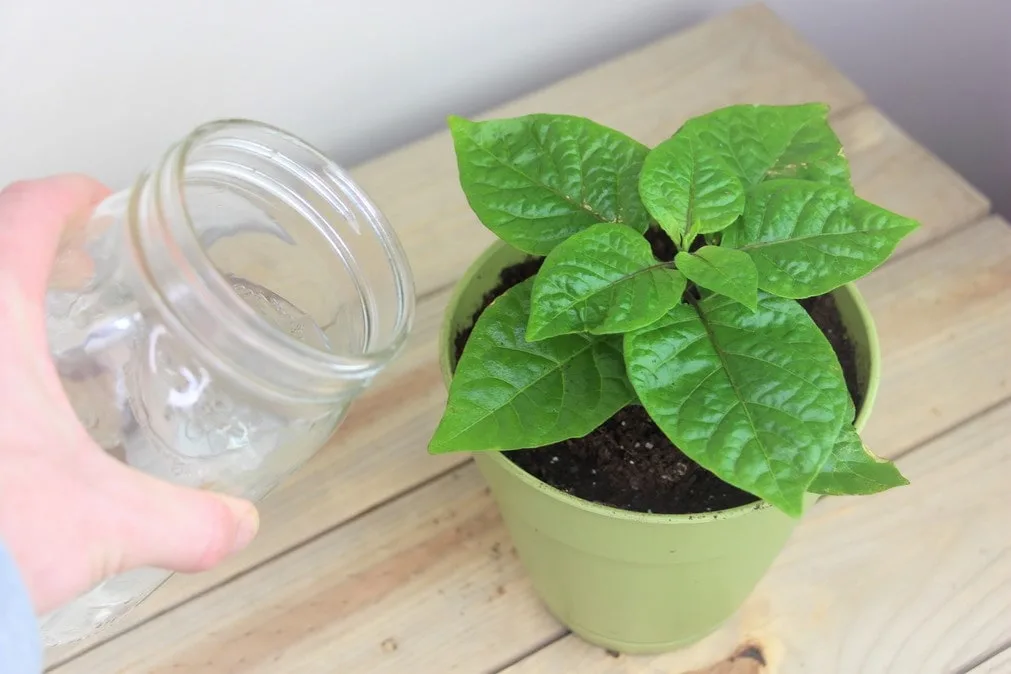
In This Article:
- How often to water pepper plants
- How to know when peppers are dry
- What time of day to water
- Water drainage
- Using the right soil
- Watering while on vacation
How Often To Water Pepper Plants
Like any plant, the watering schedule for peppers is going to vary based on your exact situation. These are some of the factors that directly influence how much water a pepper plant will use on a daily basis:
- Is the plant in the ground or a container?
- What is the average temperature?
- Is the growing container small or large?
- Is the pepper plant young or fully developed?
- Is there strong wind?
- Are you growing it indoors?
As a general rule, pepper plants should be watered about once per week and allowed to thoroughly drain. However, this frequency can vary significantly based on the temperature, wind, and the size of the plant and its growing container. During a heat wave, you may need to water your potted peppers every day!
For example, a 10 gallon planter pot will take much longer to dry out than a 1 gallon sized pot. And in general, in-ground plants will take much longer to dry out than potted plants.
If you’re unsure, try using a cheap moisture meter like this one on Amazon to get an instant read on the soil’s moisture level. While they aren’t always accurate, it can help you get a read on deep soil moisture.
Tip: Water deeply and less frequently. Allowing the soil to dry between waterings encourages deeper root growth, leading to an overall healthier plant.
In general, peppers prefer being dry to being too wet. Allow your peppers to dry out a bit between watering to avoid having constantly moist soil. Remember, the deeper soil retains moisture for longer than the surface!
Use mulch to water less often
One of the best ways to reduce the need to water is to mulch your garden. This is mostly helpful for in-ground plants, but it can also benefit potted peppers.
We like to use leaf mulch, straw, or grass clippings for our garden, but wood chips can be used as well to protect the soil’s moisture. As it rains, the mulch will allow the water to reach the soil, but will protect it from evaporation and excess heat.
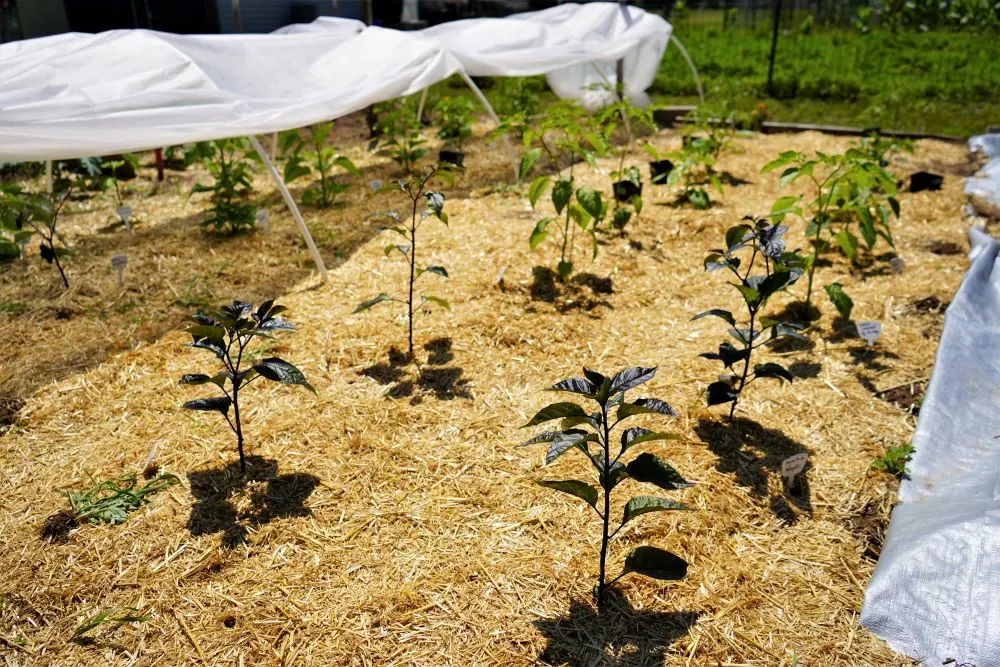
Mulch also helps to suppress weeds, and to protect the roots from a cold night, so it is really a win win (win!). Again, mulching is a best practice particularly for in-ground or raised bed gardening.
How To Tell When Pepper Plants Are Dry
Perhaps just as important as how often to water pepper plants is knowing when they are dry. Since peppers can have such a variable rate of water usage, it is good to know the warning signs of a dry plant.
There are a few methods to know when your pepper plant is thirsty for water. Use your best judgement, and know that as time goes on, you’ll get better at spotting a dry plant!
Feel the soil
The simplest method for measuring a plant’s dryness is to use your fingers to feel the surface of the soil. Push your finger about an inch below the surface to feel for moisture. If it is dry below the surface, it is safe to water.
If you are growing in pots, you can also lift the entire potted plant to gauge the weight of the soil. As the water is used by the plant, the pot will become lighter. You will get the hang of knowing when to water based on the pepper plant’s weight.
Fun Fact: Drying out hot pepper plants during the fruiting stage causes the peppers to be spicier. This is known as “stressing” the plant and it is commonly used to grow hotter peppers.
Check the leaves
When a pepper plant becomes severely dried out, the leaves will begin to wilt. They will also feel very delicate and limp to the touch. This means that the root system is almost completely dried out and you should water thoroughly, right away.
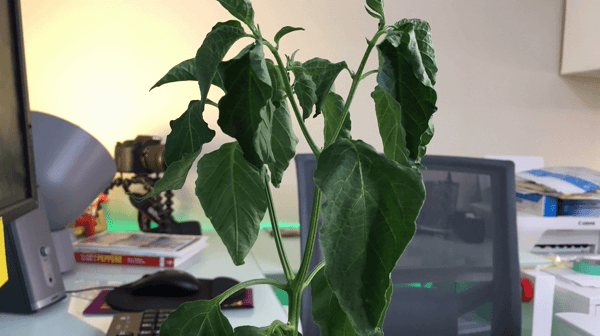
Thankfully, this is usually no issue for the pepper plant and it should fully recover in a matter of hours after being watered. However, allowing plants to wilt too frequently can cause soil quality to diminish, so try to water before wilting occurs.
Lift potted plants
If you’re growing in pots, give them a lift to get used to the weight. After watering, the pots will be significantly heavier. When they become dry, they’ll be lightweight and susceptible to falling over.
Use a moisture meter
If you are growing outside or in larger pots, a moisture meter can help determine the water levels deeper in the soil. Moisture meters work by measuring how well electricity can be conducted through the soil.
Water is a conductor of electricity, so if the electrical signal is stronger, the moisture reading is higher. This meter is cheap and works instantly. If the meter measures ‘dry’ then it is time to water. As a bonus, this model also measures pH and light intensity.
What Time Of Day To Water Peppers
This may seem like an odd topic, but when you are watering your pepper plants can make a difference. We recommend that you water pepper plants in the early morning when the sun is starting to rise, or later in the evening around sunset.
This will help avoid the possibility of the sun evaporating some of the water.
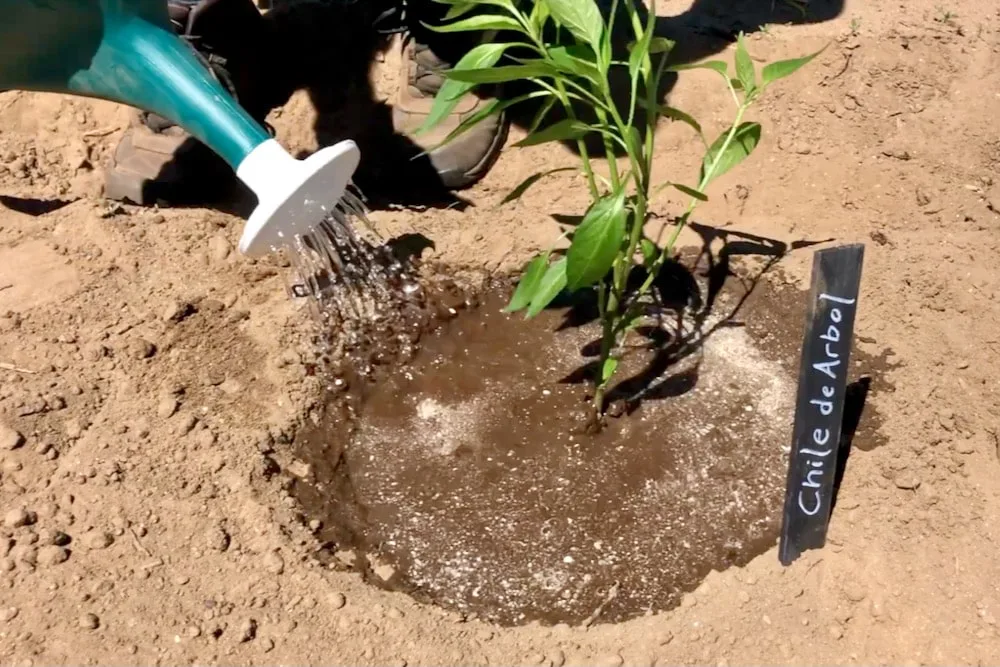
If you must water your pepper plants during the day, be sure to water at the base of the plant below the leaves. If you get some water on the leaves, don’t worry too much, as it will quickly dry.
Drainage is Key to Healthy Pepper Plants
It is one thing to know when your plants are dry, but what about when they are too wet? We have written extensively about common pepper plant issues, like yellowing leaves and curling leaves. Many of them stem from over-watering or poor drainage.
It is less likely that you’ll have issues with your peppers if you under-water than if you over-water. One of the best ways to avoid over-watering is the allow for proper drainage.

Most pots come with an attachable bottom that is intended to catch water after it flows through and soaks the soil. However, if you leave these clipped in place, the planter may not be able to release water, and the soil can become muddy and soaked.
Peppers do not tolerate highly moist conditions for very long and prefer to have soil on the dry side. So make sure that your pots are draining after you water. You can use a plant saucer or a seed starting tray to catch excess water, but just be sure the holes in your pots are free to let water out.
If your plants are in the ground, drainage can be a bit more tricky. Planting your peppers on a mound is a common practice for good drainage in heavy soils. This allows water to run away from the roots of your plants so that they don’t sit in soaked soil for too long.
Perhaps just as important as water drainage is the actual makeup of your soil. Different soil contents will determine how well it drains, as well as how well it holds nutrients.
Using The Right Soil
Having the proper soil composition can make a world of difference in your success with growing peppers. The ideal soil for pepper plants is a well-drained, sandy loam with high levels of organic material (source).
If that went right over your head, not to worry. There are 4 major components to common garden soil: Sand, silt, clay, and organic matter. The perfect sandy loam soil is essentially equal parts sand and silt, with a lower amount of clay. Each soil component has unique attributes.
- Sand contains the largest particles, allowing for great drainage and root penetration. It is essential for peppers to have enough sand to allow for drainage and to avoid root death. For peppers, the percentage of sand should be around 40%.
- Silt contains smaller particles than sand, which is perfect for nutrient retention and delivery to your peppers. Having a higher quantity of silt in your soil will mean less watering. For peppers, the percentage of silt should be around 40%.
- Clay contains the finest particles, allowing for maximum nutrient storage. However, without much room for air and water, soil that is too high in clay could spell disaster for pepper plants. For peppers, the ideal percentage of clay is around 15%.
- Organic material is the final component of healthy garden soil. The most commonly used organic material is homemade compost. Composting your food waste is a simple and affordable way to add a tremendous amount of nutrients to your soil. For peppers, try to work some organic material into your garden soil every year for a percentage of around 5%.
So how can you achieve the perfect soil composition? Unfortunately, you can’t simply buy the perfect mixture from the store. Cheap, store-bought soils tend to be made of peat moss or coir, and are not true “soil.”
See our favorite soils for peppers here.
The best method for achieving a perfect loam soil is by regularly adding organic material to your garden each year. This means compost and manures. To put it simply: Start composting!
Watering Pepper Plants While Away
It might sound ridiculous to pay someone to come and take care of watering your pepper plants while you’re away from home. You’ve worked hard to keep your plants happy and healthy, so letting them die while you’re away is a huge waste.
However, if you can’t bring yourself to ask the neighbor or a friend to swing by to give the plants water, you have other options.
For potted plants – use a pump
We bought a small pump for exactly this purpose. This batter-powered device can pump water from a reservoir (like a bucket) and deliver it to multiple stakes at the base of your pepper plants. The only drawback is that the pump does not deliver very much water at a time. It can run for up to 90 seconds per watering, twice per day. This is plenty for our smaller potted pepper plants, and is certainly a lot better than no water at all.
Video Of Our Water Pump In Action:
We would recommend using a pump for irrigation if you plan to spend at least a week away from your plants. If you live in a hot, dry climate, you may need to water more frequently, so a pump could be a lifesaver.
For raise beds, use a soaker hose
Soaker hoses are excellent for automating your irrigation. If you are busy, or plan to leave for an extended period of time, a soaker hose along with a hose timer will give you peace of mind.
They are essentially porous hoses that you lay on the soil in early spring. Whenever the spigot is turned on, the water leaks out of the hose, effectively watering all the plants that it runs past.
I hope this article helps you know when to water and when not to water your pepper plants. Watering is essential, but it is important to only do it when the plant truly needs it!
A pepper plant can handle some drying out, but will not tolerate soaking wet soil for very long. Good luck, and feel free to share your thoughts with us below.
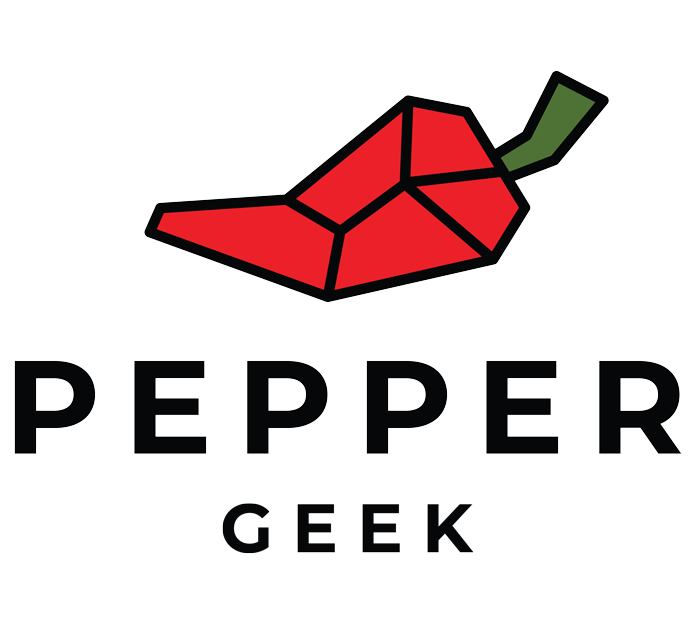



Aleko Alexander
Saturday 3rd of February 2024
Hi Calvin Thanks heaps for all the valuable information. Your insight is awesome. I’ll keep coming back to your website for inspiration, advice and guidance. Your expression is excellent and easy to follow. I’m so glad I discovered your website. I will tell my friends and family about your website. Please keep up the great work and thank you 🙏 for sharing all your knowledge. Aleko from Torquay in Melbourne.
peppergeek
Tuesday 6th of February 2024
That is great to hear, I'm happy you enjoy the website. Hope you have a great season going right now!
Leslie Fields
Thursday 3rd of August 2023
Waiting for my green peppers to turn red but many are getting brown areas before turning red. Suggestions please.
Deena
Tuesday 18th of July 2023
I have a few different varieties of sweet peppers in pots and in a raised bed (first time ever having a raised bed). The plants in the pots are doing a lot better than the ones in the raised bed and I think it's because the soil is too wet in the raised bed. I was trying to let it dry out a bit and not water, but we've had 2 days with a heavy down pour of rain and more in the forecast. What suggestions do you have to protect the plants from more rain?
Steve Johnson
Sunday 16th of July 2023
I have peppers in 7 gallon grow bags. I'm worried all the rain is washing away my nutrients for the plants. I use liquid fertilizer but my plants don't need more water. What do I do?
peppergeek
Tuesday 18th of July 2023
I would give them a light watering with nutrients to replenish - not a big risk of over-watering in grow bags!
Bruce Smith
Sunday 16th of July 2023
I use a drip system. My part of California will be 110 this afternoon. I'll water 3 times today to keep my garden alive. I am more worried about sunburn on my sweet peppers and will use shade cloth again today.